Agriculture Reforms Assignment PDF
VerifiedAdded on 2021/06/14
|14
|3376
|82
AI Summary
Contribute Materials
Your contribution can guide someone’s learning journey. Share your
documents today.

Running Head: AGRICULTURE REFORMS 1
TO:
FROM:
DATE:
SUBJECT:
TO:
FROM:
DATE:
SUBJECT:
Secure Best Marks with AI Grader
Need help grading? Try our AI Grader for instant feedback on your assignments.
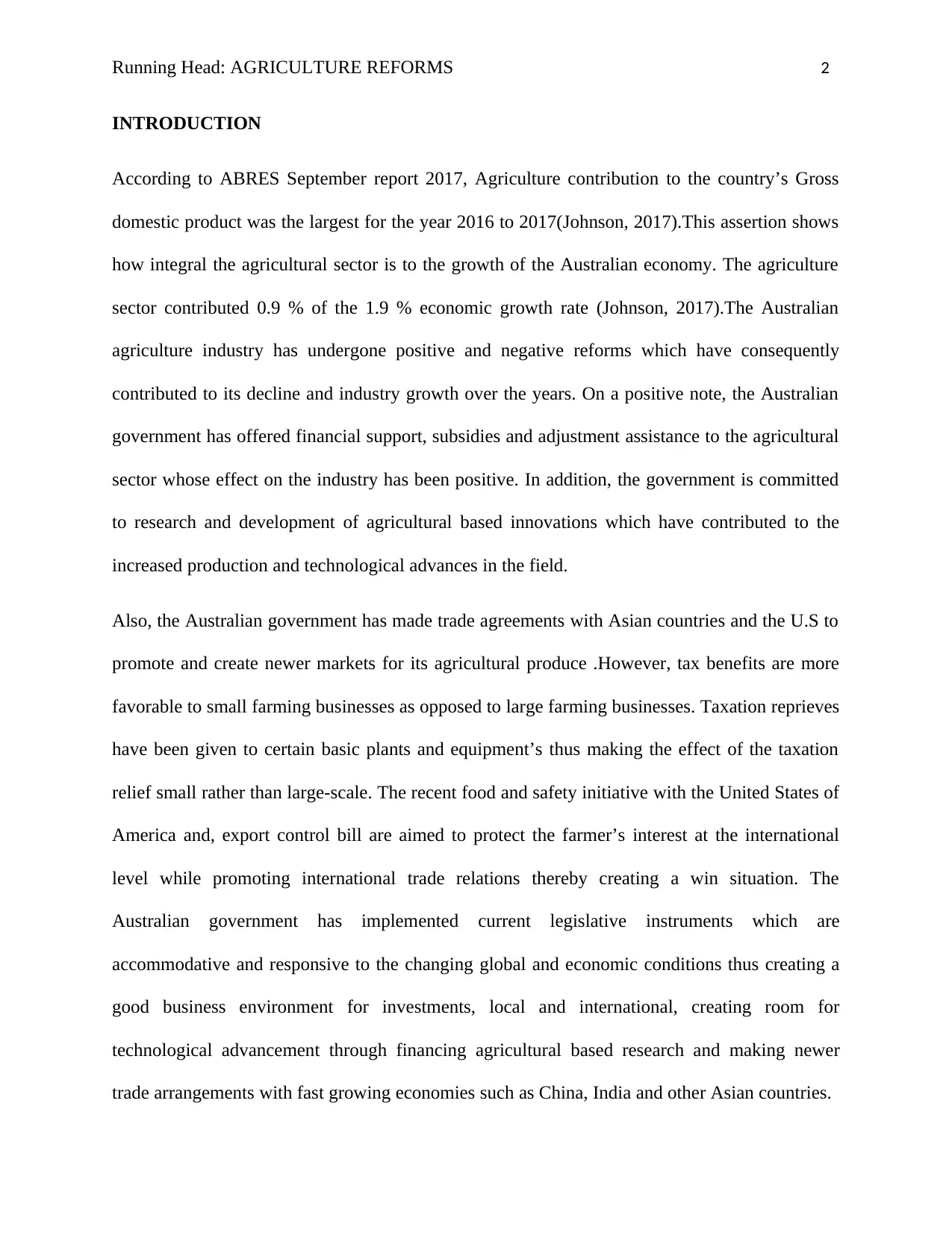
Running Head: AGRICULTURE REFORMS 2
INTRODUCTION
According to ABRES September report 2017, Agriculture contribution to the country’s Gross
domestic product was the largest for the year 2016 to 2017(Johnson, 2017).This assertion shows
how integral the agricultural sector is to the growth of the Australian economy. The agriculture
sector contributed 0.9 % of the 1.9 % economic growth rate (Johnson, 2017).The Australian
agriculture industry has undergone positive and negative reforms which have consequently
contributed to its decline and industry growth over the years. On a positive note, the Australian
government has offered financial support, subsidies and adjustment assistance to the agricultural
sector whose effect on the industry has been positive. In addition, the government is committed
to research and development of agricultural based innovations which have contributed to the
increased production and technological advances in the field.
Also, the Australian government has made trade agreements with Asian countries and the U.S to
promote and create newer markets for its agricultural produce .However, tax benefits are more
favorable to small farming businesses as opposed to large farming businesses. Taxation reprieves
have been given to certain basic plants and equipment’s thus making the effect of the taxation
relief small rather than large-scale. The recent food and safety initiative with the United States of
America and, export control bill are aimed to protect the farmer’s interest at the international
level while promoting international trade relations thereby creating a win situation. The
Australian government has implemented current legislative instruments which are
accommodative and responsive to the changing global and economic conditions thus creating a
good business environment for investments, local and international, creating room for
technological advancement through financing agricultural based research and making newer
trade arrangements with fast growing economies such as China, India and other Asian countries.
INTRODUCTION
According to ABRES September report 2017, Agriculture contribution to the country’s Gross
domestic product was the largest for the year 2016 to 2017(Johnson, 2017).This assertion shows
how integral the agricultural sector is to the growth of the Australian economy. The agriculture
sector contributed 0.9 % of the 1.9 % economic growth rate (Johnson, 2017).The Australian
agriculture industry has undergone positive and negative reforms which have consequently
contributed to its decline and industry growth over the years. On a positive note, the Australian
government has offered financial support, subsidies and adjustment assistance to the agricultural
sector whose effect on the industry has been positive. In addition, the government is committed
to research and development of agricultural based innovations which have contributed to the
increased production and technological advances in the field.
Also, the Australian government has made trade agreements with Asian countries and the U.S to
promote and create newer markets for its agricultural produce .However, tax benefits are more
favorable to small farming businesses as opposed to large farming businesses. Taxation reprieves
have been given to certain basic plants and equipment’s thus making the effect of the taxation
relief small rather than large-scale. The recent food and safety initiative with the United States of
America and, export control bill are aimed to protect the farmer’s interest at the international
level while promoting international trade relations thereby creating a win situation. The
Australian government has implemented current legislative instruments which are
accommodative and responsive to the changing global and economic conditions thus creating a
good business environment for investments, local and international, creating room for
technological advancement through financing agricultural based research and making newer
trade arrangements with fast growing economies such as China, India and other Asian countries.
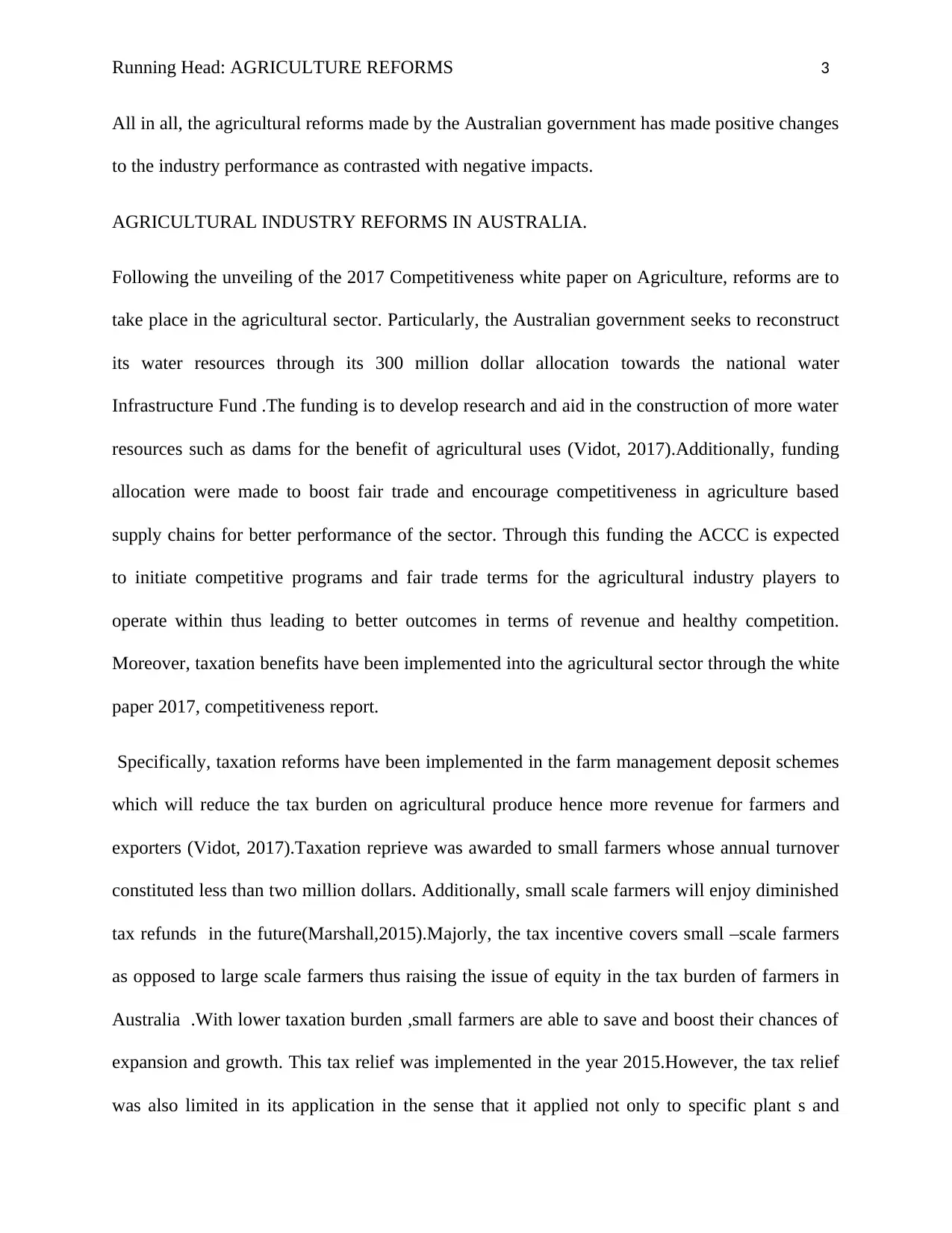
Running Head: AGRICULTURE REFORMS 3
All in all, the agricultural reforms made by the Australian government has made positive changes
to the industry performance as contrasted with negative impacts.
AGRICULTURAL INDUSTRY REFORMS IN AUSTRALIA.
Following the unveiling of the 2017 Competitiveness white paper on Agriculture, reforms are to
take place in the agricultural sector. Particularly, the Australian government seeks to reconstruct
its water resources through its 300 million dollar allocation towards the national water
Infrastructure Fund .The funding is to develop research and aid in the construction of more water
resources such as dams for the benefit of agricultural uses (Vidot, 2017).Additionally, funding
allocation were made to boost fair trade and encourage competitiveness in agriculture based
supply chains for better performance of the sector. Through this funding the ACCC is expected
to initiate competitive programs and fair trade terms for the agricultural industry players to
operate within thus leading to better outcomes in terms of revenue and healthy competition.
Moreover, taxation benefits have been implemented into the agricultural sector through the white
paper 2017, competitiveness report.
Specifically, taxation reforms have been implemented in the farm management deposit schemes
which will reduce the tax burden on agricultural produce hence more revenue for farmers and
exporters (Vidot, 2017).Taxation reprieve was awarded to small farmers whose annual turnover
constituted less than two million dollars. Additionally, small scale farmers will enjoy diminished
tax refunds in the future(Marshall,2015).Majorly, the tax incentive covers small –scale farmers
as opposed to large scale farmers thus raising the issue of equity in the tax burden of farmers in
Australia .With lower taxation burden ,small farmers are able to save and boost their chances of
expansion and growth. This tax relief was implemented in the year 2015.However, the tax relief
was also limited in its application in the sense that it applied not only to specific plant s and
All in all, the agricultural reforms made by the Australian government has made positive changes
to the industry performance as contrasted with negative impacts.
AGRICULTURAL INDUSTRY REFORMS IN AUSTRALIA.
Following the unveiling of the 2017 Competitiveness white paper on Agriculture, reforms are to
take place in the agricultural sector. Particularly, the Australian government seeks to reconstruct
its water resources through its 300 million dollar allocation towards the national water
Infrastructure Fund .The funding is to develop research and aid in the construction of more water
resources such as dams for the benefit of agricultural uses (Vidot, 2017).Additionally, funding
allocation were made to boost fair trade and encourage competitiveness in agriculture based
supply chains for better performance of the sector. Through this funding the ACCC is expected
to initiate competitive programs and fair trade terms for the agricultural industry players to
operate within thus leading to better outcomes in terms of revenue and healthy competition.
Moreover, taxation benefits have been implemented into the agricultural sector through the white
paper 2017, competitiveness report.
Specifically, taxation reforms have been implemented in the farm management deposit schemes
which will reduce the tax burden on agricultural produce hence more revenue for farmers and
exporters (Vidot, 2017).Taxation reprieve was awarded to small farmers whose annual turnover
constituted less than two million dollars. Additionally, small scale farmers will enjoy diminished
tax refunds in the future(Marshall,2015).Majorly, the tax incentive covers small –scale farmers
as opposed to large scale farmers thus raising the issue of equity in the tax burden of farmers in
Australia .With lower taxation burden ,small farmers are able to save and boost their chances of
expansion and growth. This tax relief was implemented in the year 2015.However, the tax relief
was also limited in its application in the sense that it applied not only to specific plant s and
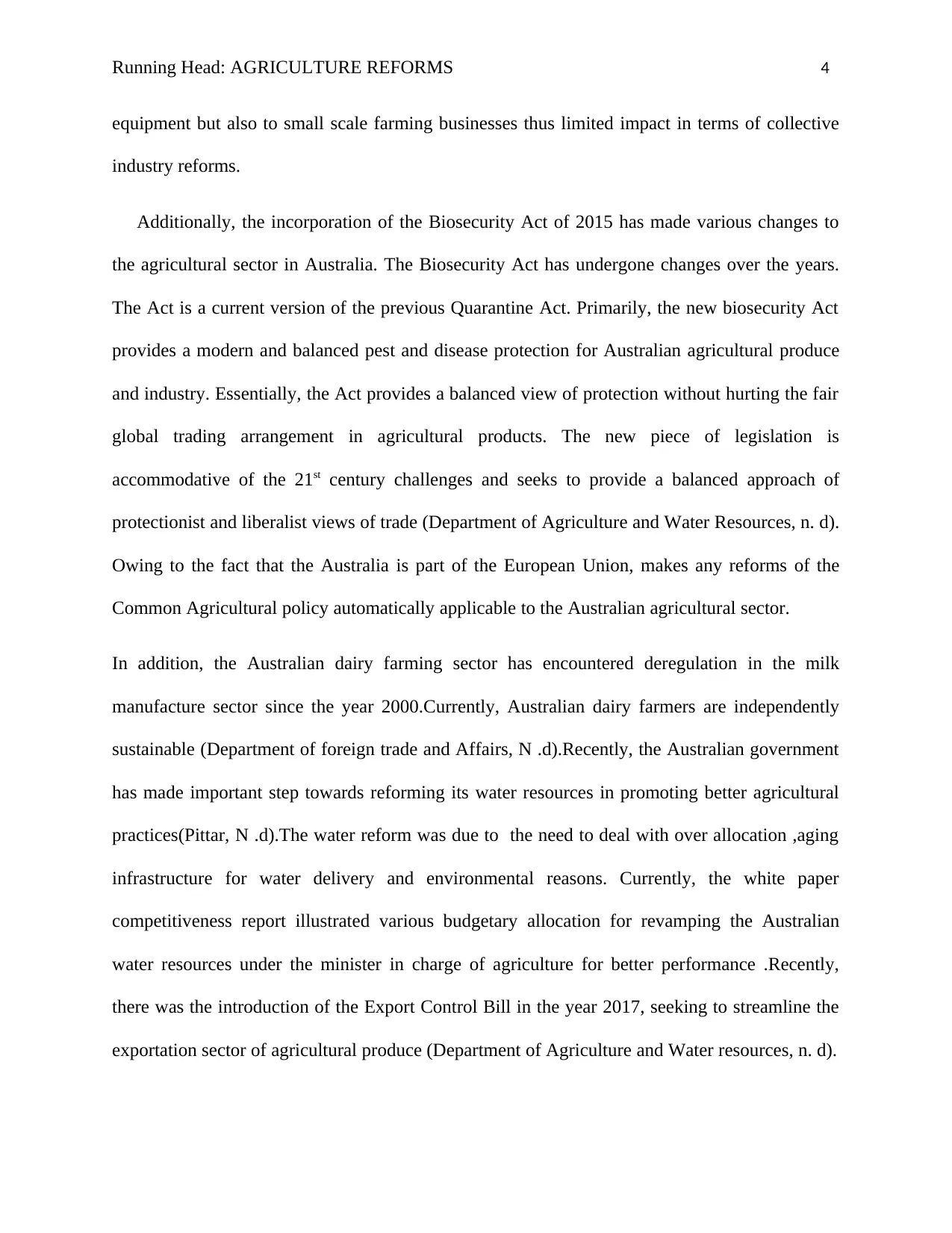
Running Head: AGRICULTURE REFORMS 4
equipment but also to small scale farming businesses thus limited impact in terms of collective
industry reforms.
Additionally, the incorporation of the Biosecurity Act of 2015 has made various changes to
the agricultural sector in Australia. The Biosecurity Act has undergone changes over the years.
The Act is a current version of the previous Quarantine Act. Primarily, the new biosecurity Act
provides a modern and balanced pest and disease protection for Australian agricultural produce
and industry. Essentially, the Act provides a balanced view of protection without hurting the fair
global trading arrangement in agricultural products. The new piece of legislation is
accommodative of the 21st century challenges and seeks to provide a balanced approach of
protectionist and liberalist views of trade (Department of Agriculture and Water Resources, n. d).
Owing to the fact that the Australia is part of the European Union, makes any reforms of the
Common Agricultural policy automatically applicable to the Australian agricultural sector.
In addition, the Australian dairy farming sector has encountered deregulation in the milk
manufacture sector since the year 2000.Currently, Australian dairy farmers are independently
sustainable (Department of foreign trade and Affairs, N .d).Recently, the Australian government
has made important step towards reforming its water resources in promoting better agricultural
practices(Pittar, N .d).The water reform was due to the need to deal with over allocation ,aging
infrastructure for water delivery and environmental reasons. Currently, the white paper
competitiveness report illustrated various budgetary allocation for revamping the Australian
water resources under the minister in charge of agriculture for better performance .Recently,
there was the introduction of the Export Control Bill in the year 2017, seeking to streamline the
exportation sector of agricultural produce (Department of Agriculture and Water resources, n. d).
equipment but also to small scale farming businesses thus limited impact in terms of collective
industry reforms.
Additionally, the incorporation of the Biosecurity Act of 2015 has made various changes to
the agricultural sector in Australia. The Biosecurity Act has undergone changes over the years.
The Act is a current version of the previous Quarantine Act. Primarily, the new biosecurity Act
provides a modern and balanced pest and disease protection for Australian agricultural produce
and industry. Essentially, the Act provides a balanced view of protection without hurting the fair
global trading arrangement in agricultural products. The new piece of legislation is
accommodative of the 21st century challenges and seeks to provide a balanced approach of
protectionist and liberalist views of trade (Department of Agriculture and Water Resources, n. d).
Owing to the fact that the Australia is part of the European Union, makes any reforms of the
Common Agricultural policy automatically applicable to the Australian agricultural sector.
In addition, the Australian dairy farming sector has encountered deregulation in the milk
manufacture sector since the year 2000.Currently, Australian dairy farmers are independently
sustainable (Department of foreign trade and Affairs, N .d).Recently, the Australian government
has made important step towards reforming its water resources in promoting better agricultural
practices(Pittar, N .d).The water reform was due to the need to deal with over allocation ,aging
infrastructure for water delivery and environmental reasons. Currently, the white paper
competitiveness report illustrated various budgetary allocation for revamping the Australian
water resources under the minister in charge of agriculture for better performance .Recently,
there was the introduction of the Export Control Bill in the year 2017, seeking to streamline the
exportation sector of agricultural produce (Department of Agriculture and Water resources, n. d).
Secure Best Marks with AI Grader
Need help grading? Try our AI Grader for instant feedback on your assignments.

Running Head: AGRICULTURE REFORMS 5
Primarily, if the piece of legislation is accented to, then the exportation of Australian agricultural
produce will be governed by new set of requirements and regulations .The new legislation seeks
to provider better and stronger support and protection to Australian farmers, producers and
exporters for the better performance of the industry. The export control legislation is aimed at
making the export conditions and environment more contemporary and responsive to the current
global trading environment due to the dynamic nature of change of the global trading scene. In
an effort to make Australian agricultural produce more competitive, the Australian government
has invested in the production and marketing of its agricultural produce .Specifically, the
Australian government has provided financial subsidies to Australian farmers so as to boost their
production by subsidizing the cost of agricultural farm inputs (Gray, Emer & Sheng, 2014).
In addition, the Australian government enforced price supportive schemes for the tobacco and
sugar industry owing to their delicate nature. To curb drought challenges for farmers, the
government introduce a drought based policy reform program which is aimed at training and
equipping farmers with the support and skills required to carry out their trade despite the harsh
economic effects of drought. Additionally, the Australian farmers have access to loan schemes
for eleven coming years as part of the government drought support program. Under this loan
system, Australian farmers will get to enjoy financial assistance to sustain and expand their
business thereby increasing their production levels, profit margins and sustaining employment
opportunities (Vidot, 2017).However ,the level of government assistance has greatly reduced
thus making the Australian agricultural industry the least subsidized in the global
environment(Farmers.Org,2017).
According to the Organization for Economic Cooperation and Development, Australian PSE
estimates are among the lowest in the world thus making the agricultural industry more efficient
Primarily, if the piece of legislation is accented to, then the exportation of Australian agricultural
produce will be governed by new set of requirements and regulations .The new legislation seeks
to provider better and stronger support and protection to Australian farmers, producers and
exporters for the better performance of the industry. The export control legislation is aimed at
making the export conditions and environment more contemporary and responsive to the current
global trading environment due to the dynamic nature of change of the global trading scene. In
an effort to make Australian agricultural produce more competitive, the Australian government
has invested in the production and marketing of its agricultural produce .Specifically, the
Australian government has provided financial subsidies to Australian farmers so as to boost their
production by subsidizing the cost of agricultural farm inputs (Gray, Emer & Sheng, 2014).
In addition, the Australian government enforced price supportive schemes for the tobacco and
sugar industry owing to their delicate nature. To curb drought challenges for farmers, the
government introduce a drought based policy reform program which is aimed at training and
equipping farmers with the support and skills required to carry out their trade despite the harsh
economic effects of drought. Additionally, the Australian farmers have access to loan schemes
for eleven coming years as part of the government drought support program. Under this loan
system, Australian farmers will get to enjoy financial assistance to sustain and expand their
business thereby increasing their production levels, profit margins and sustaining employment
opportunities (Vidot, 2017).However ,the level of government assistance has greatly reduced
thus making the Australian agricultural industry the least subsidized in the global
environment(Farmers.Org,2017).
According to the Organization for Economic Cooperation and Development, Australian PSE
estimates are among the lowest in the world thus making the agricultural industry more efficient
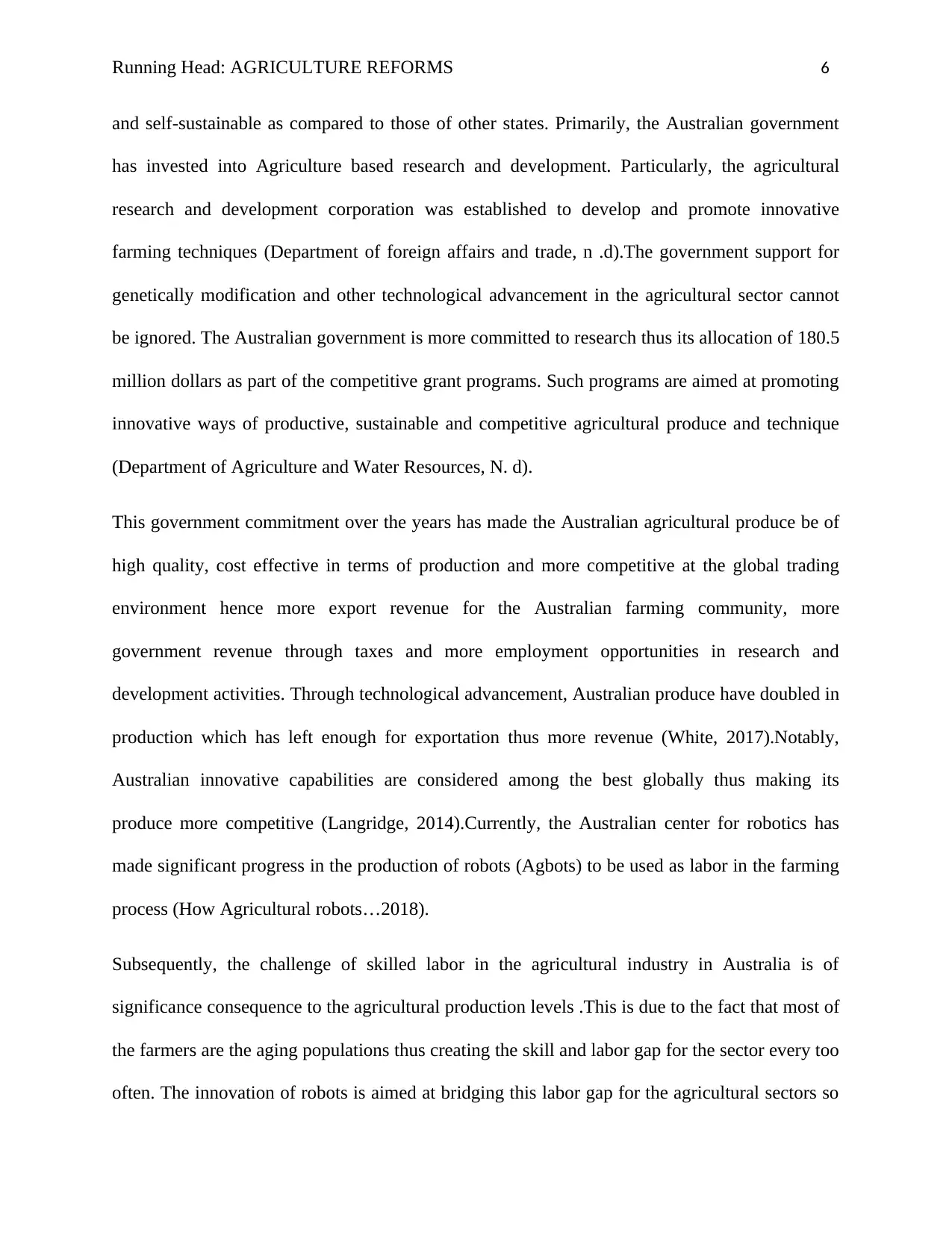
Running Head: AGRICULTURE REFORMS 6
and self-sustainable as compared to those of other states. Primarily, the Australian government
has invested into Agriculture based research and development. Particularly, the agricultural
research and development corporation was established to develop and promote innovative
farming techniques (Department of foreign affairs and trade, n .d).The government support for
genetically modification and other technological advancement in the agricultural sector cannot
be ignored. The Australian government is more committed to research thus its allocation of 180.5
million dollars as part of the competitive grant programs. Such programs are aimed at promoting
innovative ways of productive, sustainable and competitive agricultural produce and technique
(Department of Agriculture and Water Resources, N. d).
This government commitment over the years has made the Australian agricultural produce be of
high quality, cost effective in terms of production and more competitive at the global trading
environment hence more export revenue for the Australian farming community, more
government revenue through taxes and more employment opportunities in research and
development activities. Through technological advancement, Australian produce have doubled in
production which has left enough for exportation thus more revenue (White, 2017).Notably,
Australian innovative capabilities are considered among the best globally thus making its
produce more competitive (Langridge, 2014).Currently, the Australian center for robotics has
made significant progress in the production of robots (Agbots) to be used as labor in the farming
process (How Agricultural robots…2018).
Subsequently, the challenge of skilled labor in the agricultural industry in Australia is of
significance consequence to the agricultural production levels .This is due to the fact that most of
the farmers are the aging populations thus creating the skill and labor gap for the sector every too
often. The innovation of robots is aimed at bridging this labor gap for the agricultural sectors so
and self-sustainable as compared to those of other states. Primarily, the Australian government
has invested into Agriculture based research and development. Particularly, the agricultural
research and development corporation was established to develop and promote innovative
farming techniques (Department of foreign affairs and trade, n .d).The government support for
genetically modification and other technological advancement in the agricultural sector cannot
be ignored. The Australian government is more committed to research thus its allocation of 180.5
million dollars as part of the competitive grant programs. Such programs are aimed at promoting
innovative ways of productive, sustainable and competitive agricultural produce and technique
(Department of Agriculture and Water Resources, N. d).
This government commitment over the years has made the Australian agricultural produce be of
high quality, cost effective in terms of production and more competitive at the global trading
environment hence more export revenue for the Australian farming community, more
government revenue through taxes and more employment opportunities in research and
development activities. Through technological advancement, Australian produce have doubled in
production which has left enough for exportation thus more revenue (White, 2017).Notably,
Australian innovative capabilities are considered among the best globally thus making its
produce more competitive (Langridge, 2014).Currently, the Australian center for robotics has
made significant progress in the production of robots (Agbots) to be used as labor in the farming
process (How Agricultural robots…2018).
Subsequently, the challenge of skilled labor in the agricultural industry in Australia is of
significance consequence to the agricultural production levels .This is due to the fact that most of
the farmers are the aging populations thus creating the skill and labor gap for the sector every too
often. The innovation of robots is aimed at bridging this labor gap for the agricultural sectors so

Running Head: AGRICULTURE REFORMS 7
as to sustain the agriculture sector in Australia and globally. Robots are to substitute human labor
which is likely to be eroded by the quickly aging farmers who comprise the largest percentage of
skilled workers in the agricultural industry. This is a massive technological reform for the
Australian and global agricultural sector .However, the use of technologically advanced
techniques and equipment’s such as drones and other automated farming techniques has created
a huge unemployment gap (SBS News, 2018).In as much as technology advances can increase
the production and quality of agricultural produce, it risks the employment opportunities of some
workers.
Consequently, some employers might chose to let go of their employees due to the technological
benefits of this automated farming techniques thereby contribution to the unemployment levels
in the countries and lowering the economic livelihood of laid off workers. There is need to
balance the technological merits and human needs when it comes to job opportunities and
implementation. Biogenetics and other advanced technological agricultural systems have
emerged. Various agricultural sectors have encountered transformative technological
developments .Namely, biological, material, seasonal forecasting and digital sciences have
developed over time. This development has changed the agricultural sector through their costs
and outcomes to the agricultural industry. The Australian government through CSIRO has made
various notable discoveries which have increased the production of agricultural produce and
made them more competitive thus the assertion that technological advances might be good for
the development of the Australian agricultural sector (Government of Australia, N. d).
In addition to advanced technological inventions ,there is increased protection of small-scale
farmer rights when it comes to innovation and contractual relations (Wiseman,2016).In the year
2016,a mandatory “terms of use” arrangement was developed for all contracts entered into by
as to sustain the agriculture sector in Australia and globally. Robots are to substitute human labor
which is likely to be eroded by the quickly aging farmers who comprise the largest percentage of
skilled workers in the agricultural industry. This is a massive technological reform for the
Australian and global agricultural sector .However, the use of technologically advanced
techniques and equipment’s such as drones and other automated farming techniques has created
a huge unemployment gap (SBS News, 2018).In as much as technology advances can increase
the production and quality of agricultural produce, it risks the employment opportunities of some
workers.
Consequently, some employers might chose to let go of their employees due to the technological
benefits of this automated farming techniques thereby contribution to the unemployment levels
in the countries and lowering the economic livelihood of laid off workers. There is need to
balance the technological merits and human needs when it comes to job opportunities and
implementation. Biogenetics and other advanced technological agricultural systems have
emerged. Various agricultural sectors have encountered transformative technological
developments .Namely, biological, material, seasonal forecasting and digital sciences have
developed over time. This development has changed the agricultural sector through their costs
and outcomes to the agricultural industry. The Australian government through CSIRO has made
various notable discoveries which have increased the production of agricultural produce and
made them more competitive thus the assertion that technological advances might be good for
the development of the Australian agricultural sector (Government of Australia, N. d).
In addition to advanced technological inventions ,there is increased protection of small-scale
farmer rights when it comes to innovation and contractual relations (Wiseman,2016).In the year
2016,a mandatory “terms of use” arrangement was developed for all contracts entered into by
Paraphrase This Document
Need a fresh take? Get an instant paraphrase of this document with our AI Paraphraser
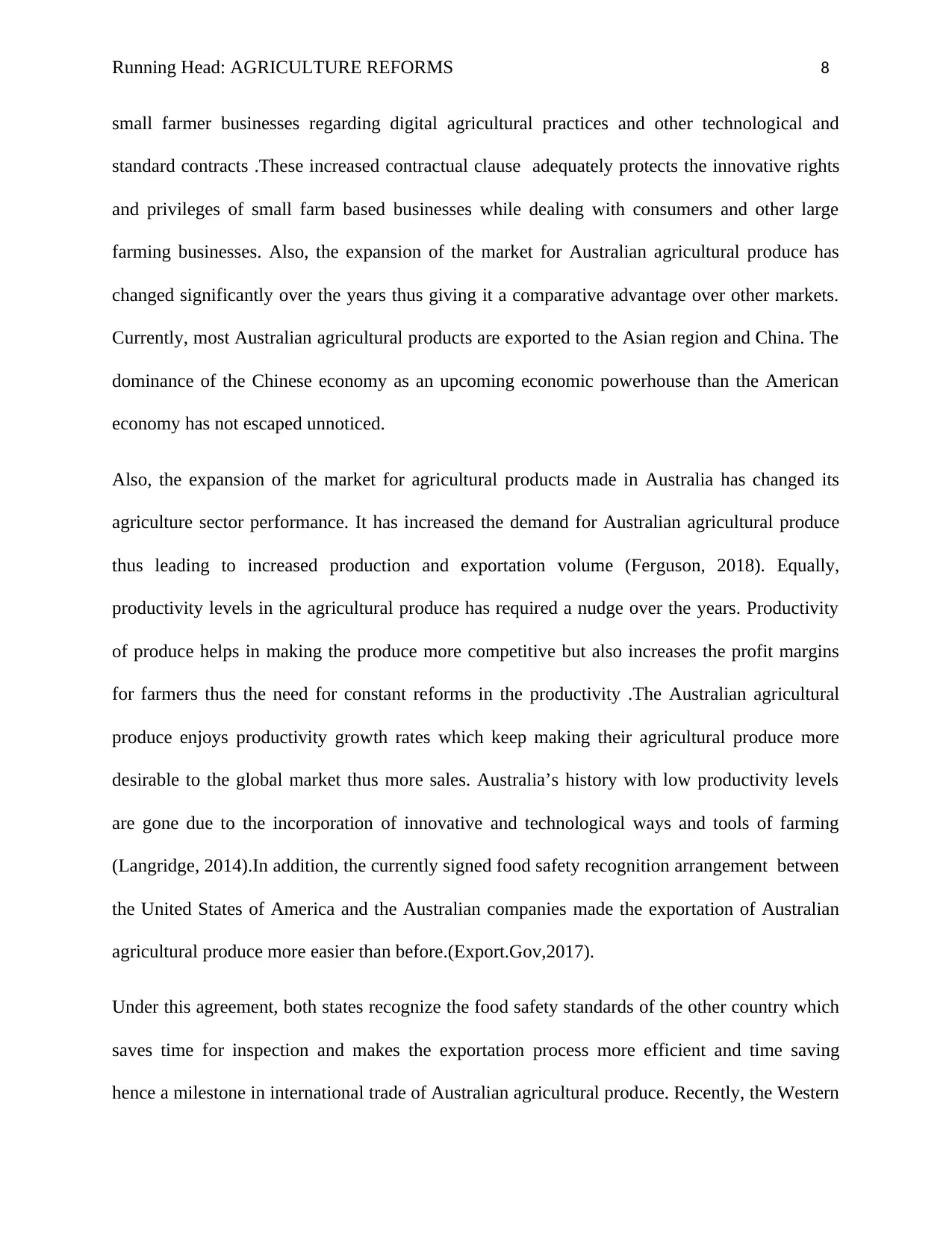
Running Head: AGRICULTURE REFORMS 8
small farmer businesses regarding digital agricultural practices and other technological and
standard contracts .These increased contractual clause adequately protects the innovative rights
and privileges of small farm based businesses while dealing with consumers and other large
farming businesses. Also, the expansion of the market for Australian agricultural produce has
changed significantly over the years thus giving it a comparative advantage over other markets.
Currently, most Australian agricultural products are exported to the Asian region and China. The
dominance of the Chinese economy as an upcoming economic powerhouse than the American
economy has not escaped unnoticed.
Also, the expansion of the market for agricultural products made in Australia has changed its
agriculture sector performance. It has increased the demand for Australian agricultural produce
thus leading to increased production and exportation volume (Ferguson, 2018). Equally,
productivity levels in the agricultural produce has required a nudge over the years. Productivity
of produce helps in making the produce more competitive but also increases the profit margins
for farmers thus the need for constant reforms in the productivity .The Australian agricultural
produce enjoys productivity growth rates which keep making their agricultural produce more
desirable to the global market thus more sales. Australia’s history with low productivity levels
are gone due to the incorporation of innovative and technological ways and tools of farming
(Langridge, 2014).In addition, the currently signed food safety recognition arrangement between
the United States of America and the Australian companies made the exportation of Australian
agricultural produce more easier than before.(Export.Gov,2017).
Under this agreement, both states recognize the food safety standards of the other country which
saves time for inspection and makes the exportation process more efficient and time saving
hence a milestone in international trade of Australian agricultural produce. Recently, the Western
small farmer businesses regarding digital agricultural practices and other technological and
standard contracts .These increased contractual clause adequately protects the innovative rights
and privileges of small farm based businesses while dealing with consumers and other large
farming businesses. Also, the expansion of the market for Australian agricultural produce has
changed significantly over the years thus giving it a comparative advantage over other markets.
Currently, most Australian agricultural products are exported to the Asian region and China. The
dominance of the Chinese economy as an upcoming economic powerhouse than the American
economy has not escaped unnoticed.
Also, the expansion of the market for agricultural products made in Australia has changed its
agriculture sector performance. It has increased the demand for Australian agricultural produce
thus leading to increased production and exportation volume (Ferguson, 2018). Equally,
productivity levels in the agricultural produce has required a nudge over the years. Productivity
of produce helps in making the produce more competitive but also increases the profit margins
for farmers thus the need for constant reforms in the productivity .The Australian agricultural
produce enjoys productivity growth rates which keep making their agricultural produce more
desirable to the global market thus more sales. Australia’s history with low productivity levels
are gone due to the incorporation of innovative and technological ways and tools of farming
(Langridge, 2014).In addition, the currently signed food safety recognition arrangement between
the United States of America and the Australian companies made the exportation of Australian
agricultural produce more easier than before.(Export.Gov,2017).
Under this agreement, both states recognize the food safety standards of the other country which
saves time for inspection and makes the exportation process more efficient and time saving
hence a milestone in international trade of Australian agricultural produce. Recently, the Western
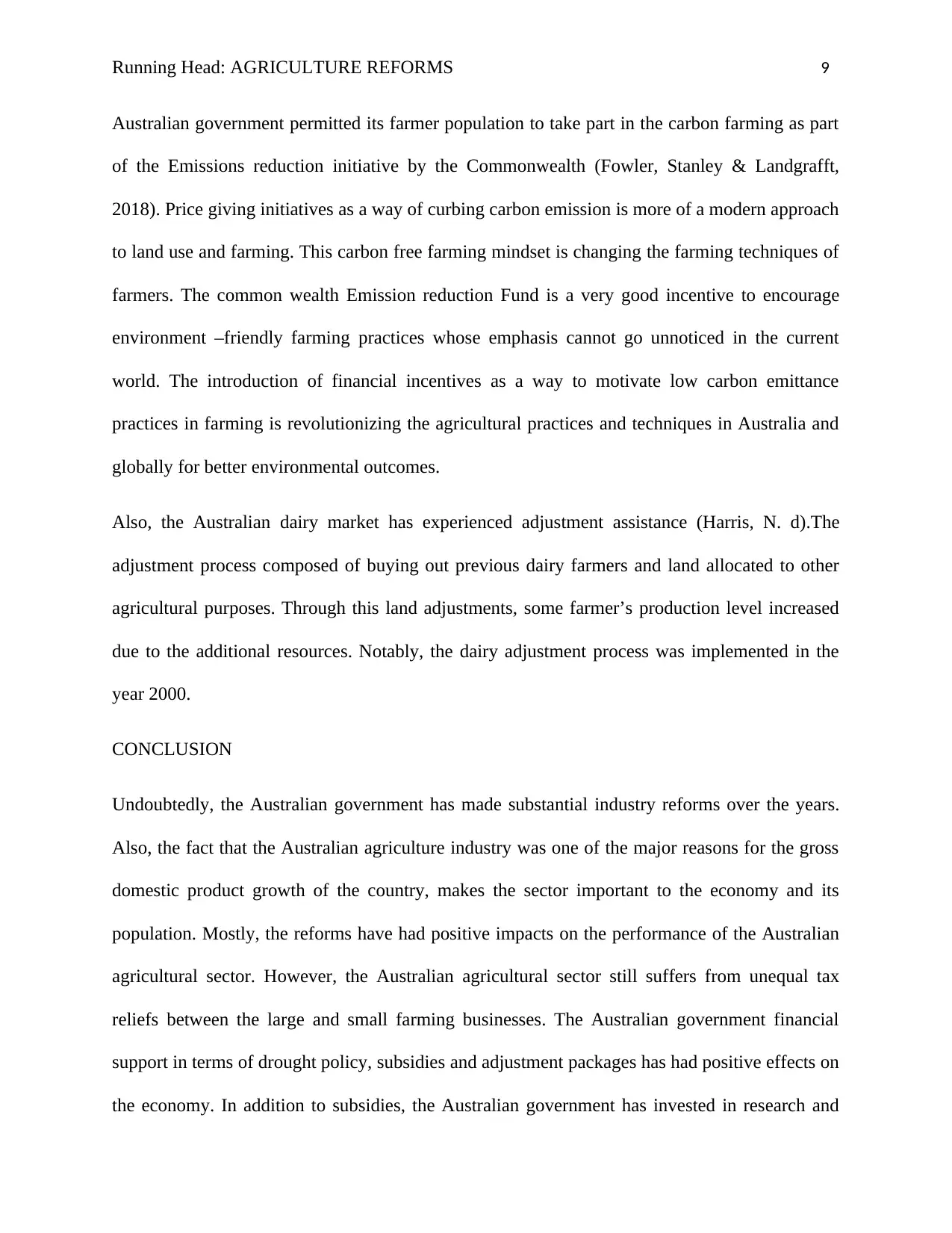
Running Head: AGRICULTURE REFORMS 9
Australian government permitted its farmer population to take part in the carbon farming as part
of the Emissions reduction initiative by the Commonwealth (Fowler, Stanley & Landgrafft,
2018). Price giving initiatives as a way of curbing carbon emission is more of a modern approach
to land use and farming. This carbon free farming mindset is changing the farming techniques of
farmers. The common wealth Emission reduction Fund is a very good incentive to encourage
environment –friendly farming practices whose emphasis cannot go unnoticed in the current
world. The introduction of financial incentives as a way to motivate low carbon emittance
practices in farming is revolutionizing the agricultural practices and techniques in Australia and
globally for better environmental outcomes.
Also, the Australian dairy market has experienced adjustment assistance (Harris, N. d).The
adjustment process composed of buying out previous dairy farmers and land allocated to other
agricultural purposes. Through this land adjustments, some farmer’s production level increased
due to the additional resources. Notably, the dairy adjustment process was implemented in the
year 2000.
CONCLUSION
Undoubtedly, the Australian government has made substantial industry reforms over the years.
Also, the fact that the Australian agriculture industry was one of the major reasons for the gross
domestic product growth of the country, makes the sector important to the economy and its
population. Mostly, the reforms have had positive impacts on the performance of the Australian
agricultural sector. However, the Australian agricultural sector still suffers from unequal tax
reliefs between the large and small farming businesses. The Australian government financial
support in terms of drought policy, subsidies and adjustment packages has had positive effects on
the economy. In addition to subsidies, the Australian government has invested in research and
Australian government permitted its farmer population to take part in the carbon farming as part
of the Emissions reduction initiative by the Commonwealth (Fowler, Stanley & Landgrafft,
2018). Price giving initiatives as a way of curbing carbon emission is more of a modern approach
to land use and farming. This carbon free farming mindset is changing the farming techniques of
farmers. The common wealth Emission reduction Fund is a very good incentive to encourage
environment –friendly farming practices whose emphasis cannot go unnoticed in the current
world. The introduction of financial incentives as a way to motivate low carbon emittance
practices in farming is revolutionizing the agricultural practices and techniques in Australia and
globally for better environmental outcomes.
Also, the Australian dairy market has experienced adjustment assistance (Harris, N. d).The
adjustment process composed of buying out previous dairy farmers and land allocated to other
agricultural purposes. Through this land adjustments, some farmer’s production level increased
due to the additional resources. Notably, the dairy adjustment process was implemented in the
year 2000.
CONCLUSION
Undoubtedly, the Australian government has made substantial industry reforms over the years.
Also, the fact that the Australian agriculture industry was one of the major reasons for the gross
domestic product growth of the country, makes the sector important to the economy and its
population. Mostly, the reforms have had positive impacts on the performance of the Australian
agricultural sector. However, the Australian agricultural sector still suffers from unequal tax
reliefs between the large and small farming businesses. The Australian government financial
support in terms of drought policy, subsidies and adjustment packages has had positive effects on
the economy. In addition to subsidies, the Australian government has invested in research and
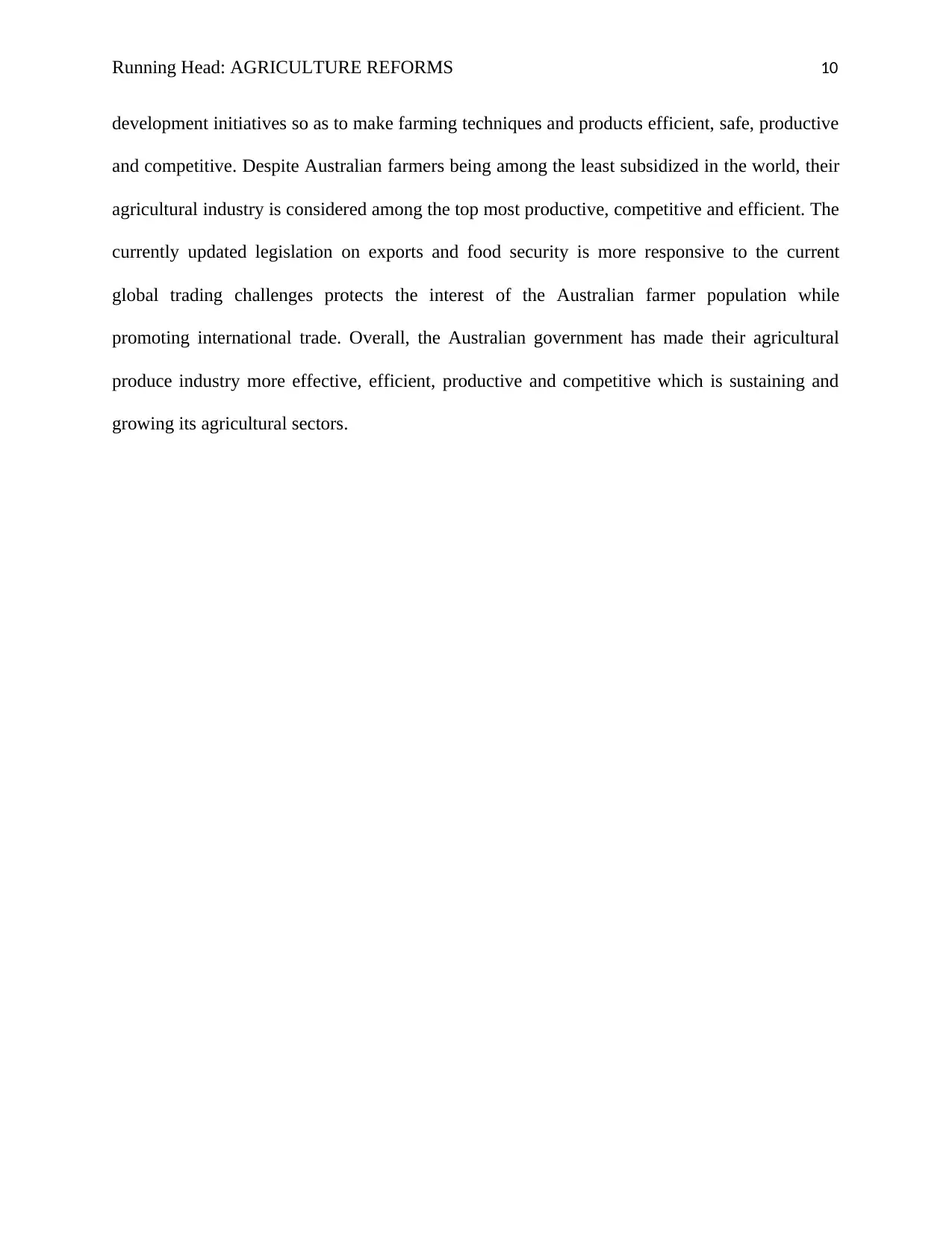
Running Head: AGRICULTURE REFORMS 10
development initiatives so as to make farming techniques and products efficient, safe, productive
and competitive. Despite Australian farmers being among the least subsidized in the world, their
agricultural industry is considered among the top most productive, competitive and efficient. The
currently updated legislation on exports and food security is more responsive to the current
global trading challenges protects the interest of the Australian farmer population while
promoting international trade. Overall, the Australian government has made their agricultural
produce industry more effective, efficient, productive and competitive which is sustaining and
growing its agricultural sectors.
development initiatives so as to make farming techniques and products efficient, safe, productive
and competitive. Despite Australian farmers being among the least subsidized in the world, their
agricultural industry is considered among the top most productive, competitive and efficient. The
currently updated legislation on exports and food security is more responsive to the current
global trading challenges protects the interest of the Australian farmer population while
promoting international trade. Overall, the Australian government has made their agricultural
produce industry more effective, efficient, productive and competitive which is sustaining and
growing its agricultural sectors.
Secure Best Marks with AI Grader
Need help grading? Try our AI Grader for instant feedback on your assignments.
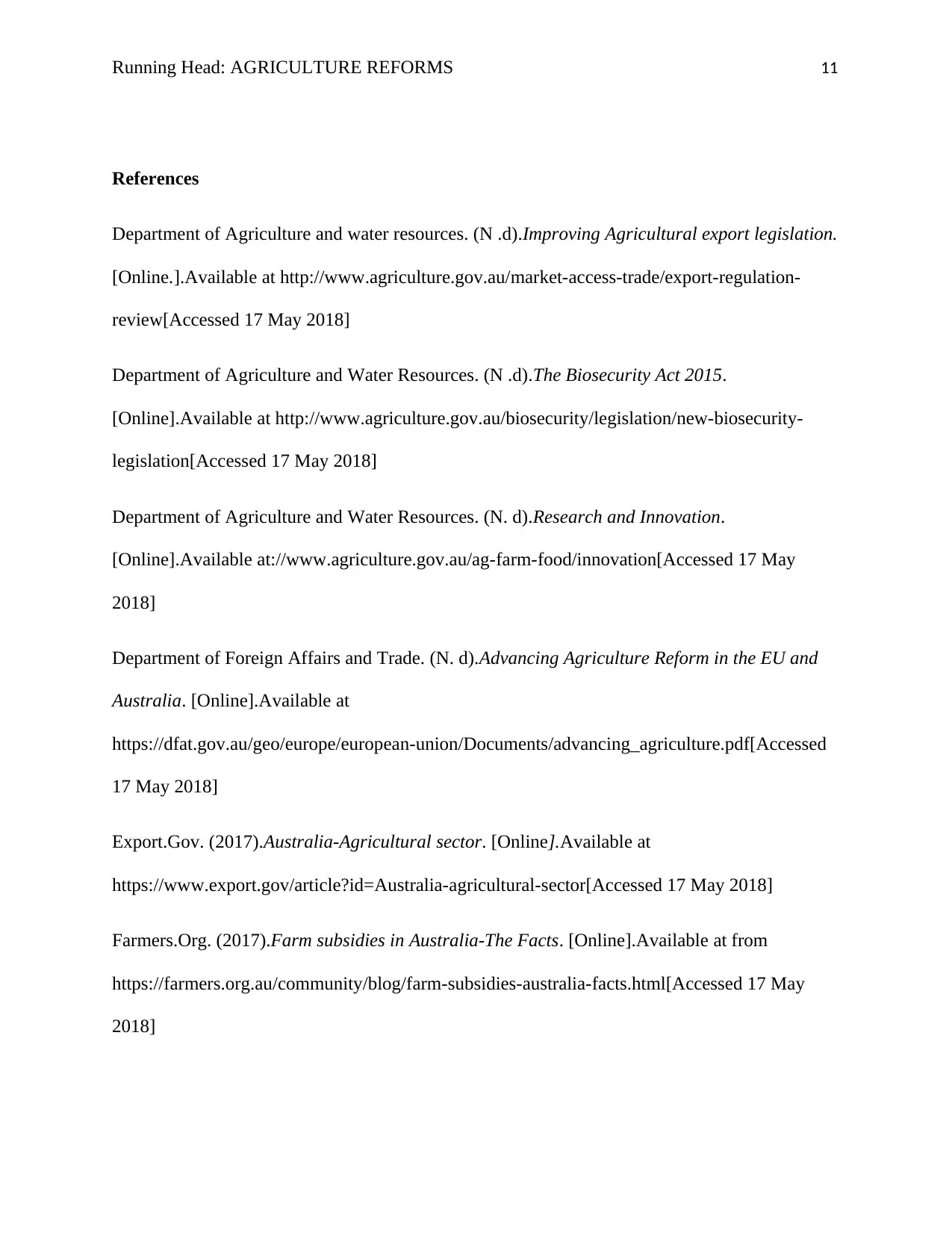
Running Head: AGRICULTURE REFORMS 11
References
Department of Agriculture and water resources. (N .d).Improving Agricultural export legislation.
[Online.].Available at http://www.agriculture.gov.au/market-access-trade/export-regulation-
review[Accessed 17 May 2018]
Department of Agriculture and Water Resources. (N .d).The Biosecurity Act 2015.
[Online].Available at http://www.agriculture.gov.au/biosecurity/legislation/new-biosecurity-
legislation[Accessed 17 May 2018]
Department of Agriculture and Water Resources. (N. d).Research and Innovation.
[Online].Available at://www.agriculture.gov.au/ag-farm-food/innovation[Accessed 17 May
2018]
Department of Foreign Affairs and Trade. (N. d).Advancing Agriculture Reform in the EU and
Australia. [Online].Available at
https://dfat.gov.au/geo/europe/european-union/Documents/advancing_agriculture.pdf[Accessed
17 May 2018]
Export.Gov. (2017).Australia-Agricultural sector. [Online].Available at
https://www.export.gov/article?id=Australia-agricultural-sector[Accessed 17 May 2018]
Farmers.Org. (2017).Farm subsidies in Australia-The Facts. [Online].Available at from
https://farmers.org.au/community/blog/farm-subsidies-australia-facts.html[Accessed 17 May
2018]
References
Department of Agriculture and water resources. (N .d).Improving Agricultural export legislation.
[Online.].Available at http://www.agriculture.gov.au/market-access-trade/export-regulation-
review[Accessed 17 May 2018]
Department of Agriculture and Water Resources. (N .d).The Biosecurity Act 2015.
[Online].Available at http://www.agriculture.gov.au/biosecurity/legislation/new-biosecurity-
legislation[Accessed 17 May 2018]
Department of Agriculture and Water Resources. (N. d).Research and Innovation.
[Online].Available at://www.agriculture.gov.au/ag-farm-food/innovation[Accessed 17 May
2018]
Department of Foreign Affairs and Trade. (N. d).Advancing Agriculture Reform in the EU and
Australia. [Online].Available at
https://dfat.gov.au/geo/europe/european-union/Documents/advancing_agriculture.pdf[Accessed
17 May 2018]
Export.Gov. (2017).Australia-Agricultural sector. [Online].Available at
https://www.export.gov/article?id=Australia-agricultural-sector[Accessed 17 May 2018]
Farmers.Org. (2017).Farm subsidies in Australia-The Facts. [Online].Available at from
https://farmers.org.au/community/blog/farm-subsidies-australia-facts.html[Accessed 17 May
2018]
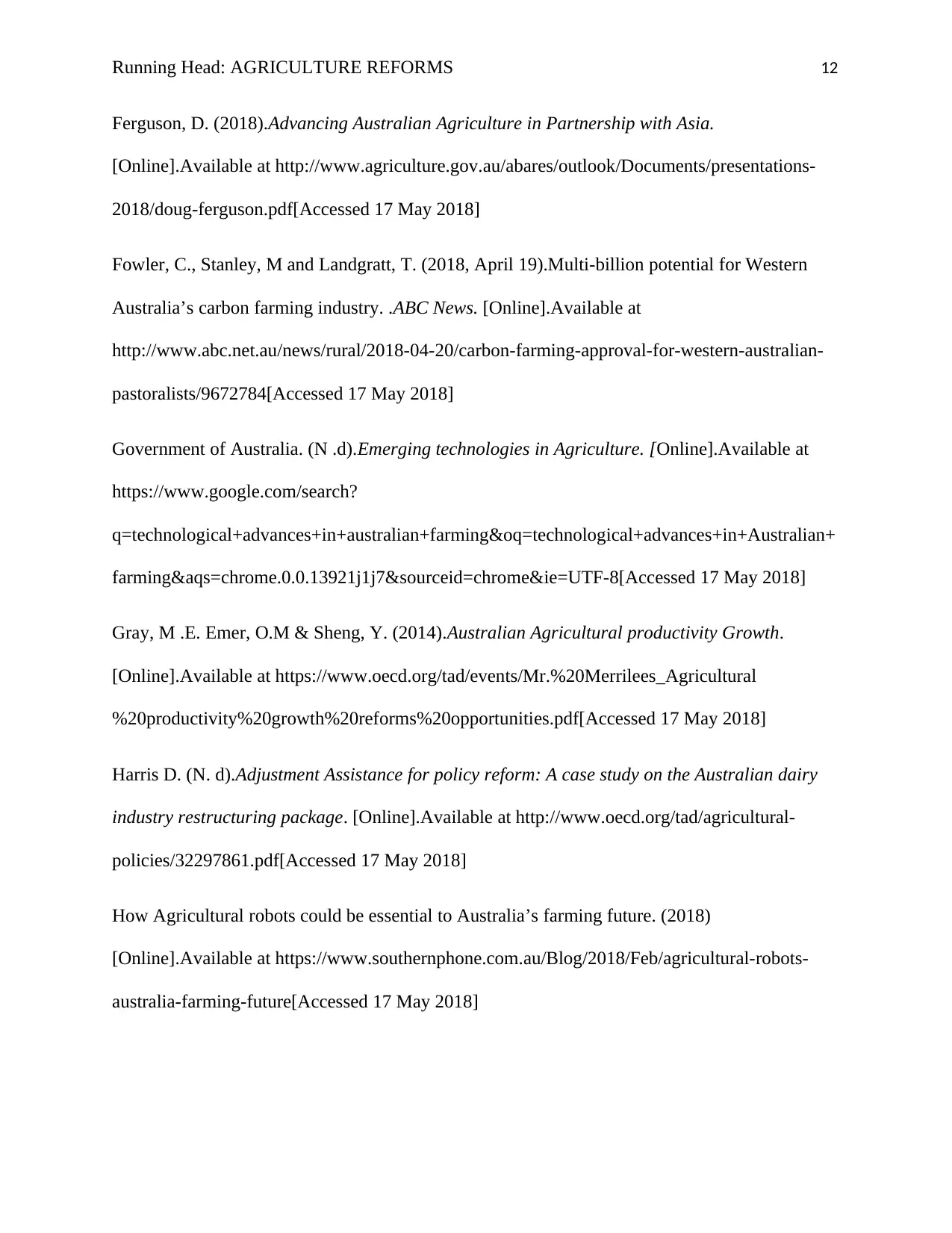
Running Head: AGRICULTURE REFORMS 12
Ferguson, D. (2018).Advancing Australian Agriculture in Partnership with Asia.
[Online].Available at http://www.agriculture.gov.au/abares/outlook/Documents/presentations-
2018/doug-ferguson.pdf[Accessed 17 May 2018]
Fowler, C., Stanley, M and Landgratt, T. (2018, April 19).Multi-billion potential for Western
Australia’s carbon farming industry. .ABC News. [Online].Available at
http://www.abc.net.au/news/rural/2018-04-20/carbon-farming-approval-for-western-australian-
pastoralists/9672784[Accessed 17 May 2018]
Government of Australia. (N .d).Emerging technologies in Agriculture. [Online].Available at
https://www.google.com/search?
q=technological+advances+in+australian+farming&oq=technological+advances+in+Australian+
farming&aqs=chrome.0.0.13921j1j7&sourceid=chrome&ie=UTF-8[Accessed 17 May 2018]
Gray, M .E. Emer, O.M & Sheng, Y. (2014).Australian Agricultural productivity Growth.
[Online].Available at https://www.oecd.org/tad/events/Mr.%20Merrilees_Agricultural
%20productivity%20growth%20reforms%20opportunities.pdf[Accessed 17 May 2018]
Harris D. (N. d).Adjustment Assistance for policy reform: A case study on the Australian dairy
industry restructuring package. [Online].Available at http://www.oecd.org/tad/agricultural-
policies/32297861.pdf[Accessed 17 May 2018]
How Agricultural robots could be essential to Australia’s farming future. (2018)
[Online].Available at https://www.southernphone.com.au/Blog/2018/Feb/agricultural-robots-
australia-farming-future[Accessed 17 May 2018]
Ferguson, D. (2018).Advancing Australian Agriculture in Partnership with Asia.
[Online].Available at http://www.agriculture.gov.au/abares/outlook/Documents/presentations-
2018/doug-ferguson.pdf[Accessed 17 May 2018]
Fowler, C., Stanley, M and Landgratt, T. (2018, April 19).Multi-billion potential for Western
Australia’s carbon farming industry. .ABC News. [Online].Available at
http://www.abc.net.au/news/rural/2018-04-20/carbon-farming-approval-for-western-australian-
pastoralists/9672784[Accessed 17 May 2018]
Government of Australia. (N .d).Emerging technologies in Agriculture. [Online].Available at
https://www.google.com/search?
q=technological+advances+in+australian+farming&oq=technological+advances+in+Australian+
farming&aqs=chrome.0.0.13921j1j7&sourceid=chrome&ie=UTF-8[Accessed 17 May 2018]
Gray, M .E. Emer, O.M & Sheng, Y. (2014).Australian Agricultural productivity Growth.
[Online].Available at https://www.oecd.org/tad/events/Mr.%20Merrilees_Agricultural
%20productivity%20growth%20reforms%20opportunities.pdf[Accessed 17 May 2018]
Harris D. (N. d).Adjustment Assistance for policy reform: A case study on the Australian dairy
industry restructuring package. [Online].Available at http://www.oecd.org/tad/agricultural-
policies/32297861.pdf[Accessed 17 May 2018]
How Agricultural robots could be essential to Australia’s farming future. (2018)
[Online].Available at https://www.southernphone.com.au/Blog/2018/Feb/agricultural-robots-
australia-farming-future[Accessed 17 May 2018]

Running Head: AGRICULTURE REFORMS 13
Johnson. R. (2017).Agriculture is now the powerhouse driving economic growth in Australia.
[Online].Available at https://www.agri.com.au/agriculture-is-now-the-powerhouse-driving-
economic-growth-in-australia/[Accessed 15 May 2018]
Langridge, P. (2014, July 15).Agriculture in Australia: Growing more than our farming future.
[Online]The Conversation. Available at https://theconversation.com/agriculture-in-australia-
growing-more-than-our-farming-future-22843[Accessed 15 May 2018]
Marshall, A. (2015).Farming‘s budget tax breaks. [Online]Available at
https://www.farmonline.com.au/story/3378411/farmings-budget-tax-breaks/[Accessed 17 May
2018]
Pittar , R. (N .d).Australia’s water reform experience and its impact on the Agricultural sector.
[Online].Available at https://www.oecd.org/greengrowth/35468753.pdf [Accessed 17 May 2018]
SBS New. (2018).Tech Innovation draws farmers of future. [Online].Available at
https://www.sbs.com.au/news/tech-innovation-draws-farmers-of-future[Accessed 17 May 2018]
Vidot, A. (2015, July 6).Federal Government unveils long-awaited plan for Australian
agriculture. ABC News. [Online]Available
athttp://www.abc.net.au/news/rural/2015-07-04/agriculture-white-paper-revealed/6594970
[Accessed 17 May 2018]
White, S. (2018, March 7).Technology changing the face of farming. The Sydney Morning
Herald. [Online].Available at: https://.www.smh.com.au/business/workplace/technology-
changing-the-face-of-farming-20180307-p4z37p.html[Accessed 17 May 2018]
Johnson. R. (2017).Agriculture is now the powerhouse driving economic growth in Australia.
[Online].Available at https://www.agri.com.au/agriculture-is-now-the-powerhouse-driving-
economic-growth-in-australia/[Accessed 15 May 2018]
Langridge, P. (2014, July 15).Agriculture in Australia: Growing more than our farming future.
[Online]The Conversation. Available at https://theconversation.com/agriculture-in-australia-
growing-more-than-our-farming-future-22843[Accessed 15 May 2018]
Marshall, A. (2015).Farming‘s budget tax breaks. [Online]Available at
https://www.farmonline.com.au/story/3378411/farmings-budget-tax-breaks/[Accessed 17 May
2018]
Pittar , R. (N .d).Australia’s water reform experience and its impact on the Agricultural sector.
[Online].Available at https://www.oecd.org/greengrowth/35468753.pdf [Accessed 17 May 2018]
SBS New. (2018).Tech Innovation draws farmers of future. [Online].Available at
https://www.sbs.com.au/news/tech-innovation-draws-farmers-of-future[Accessed 17 May 2018]
Vidot, A. (2015, July 6).Federal Government unveils long-awaited plan for Australian
agriculture. ABC News. [Online]Available
athttp://www.abc.net.au/news/rural/2015-07-04/agriculture-white-paper-revealed/6594970
[Accessed 17 May 2018]
White, S. (2018, March 7).Technology changing the face of farming. The Sydney Morning
Herald. [Online].Available at: https://.www.smh.com.au/business/workplace/technology-
changing-the-face-of-farming-20180307-p4z37p.html[Accessed 17 May 2018]
Paraphrase This Document
Need a fresh take? Get an instant paraphrase of this document with our AI Paraphraser

Running Head: AGRICULTURE REFORMS 14
Wiseman .L. (2016, November 25).Changes to contract laws could give small farming
businesses more control of data and innovation. [Online].The Conversation. Available at
https://theconversation.com/changes-to-contract-laws-could-give-small-farming-businesses-
more-control-of-data-and-innovation-69275[Accessed 17 May 2018]
Wiseman .L. (2016, November 25).Changes to contract laws could give small farming
businesses more control of data and innovation. [Online].The Conversation. Available at
https://theconversation.com/changes-to-contract-laws-could-give-small-farming-businesses-
more-control-of-data-and-innovation-69275[Accessed 17 May 2018]
1 out of 14
Related Documents
Your All-in-One AI-Powered Toolkit for Academic Success.
+13062052269
info@desklib.com
Available 24*7 on WhatsApp / Email
![[object Object]](/_next/static/media/star-bottom.7253800d.svg)
Unlock your academic potential
© 2024 | Zucol Services PVT LTD | All rights reserved.





